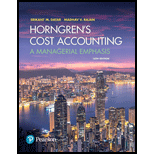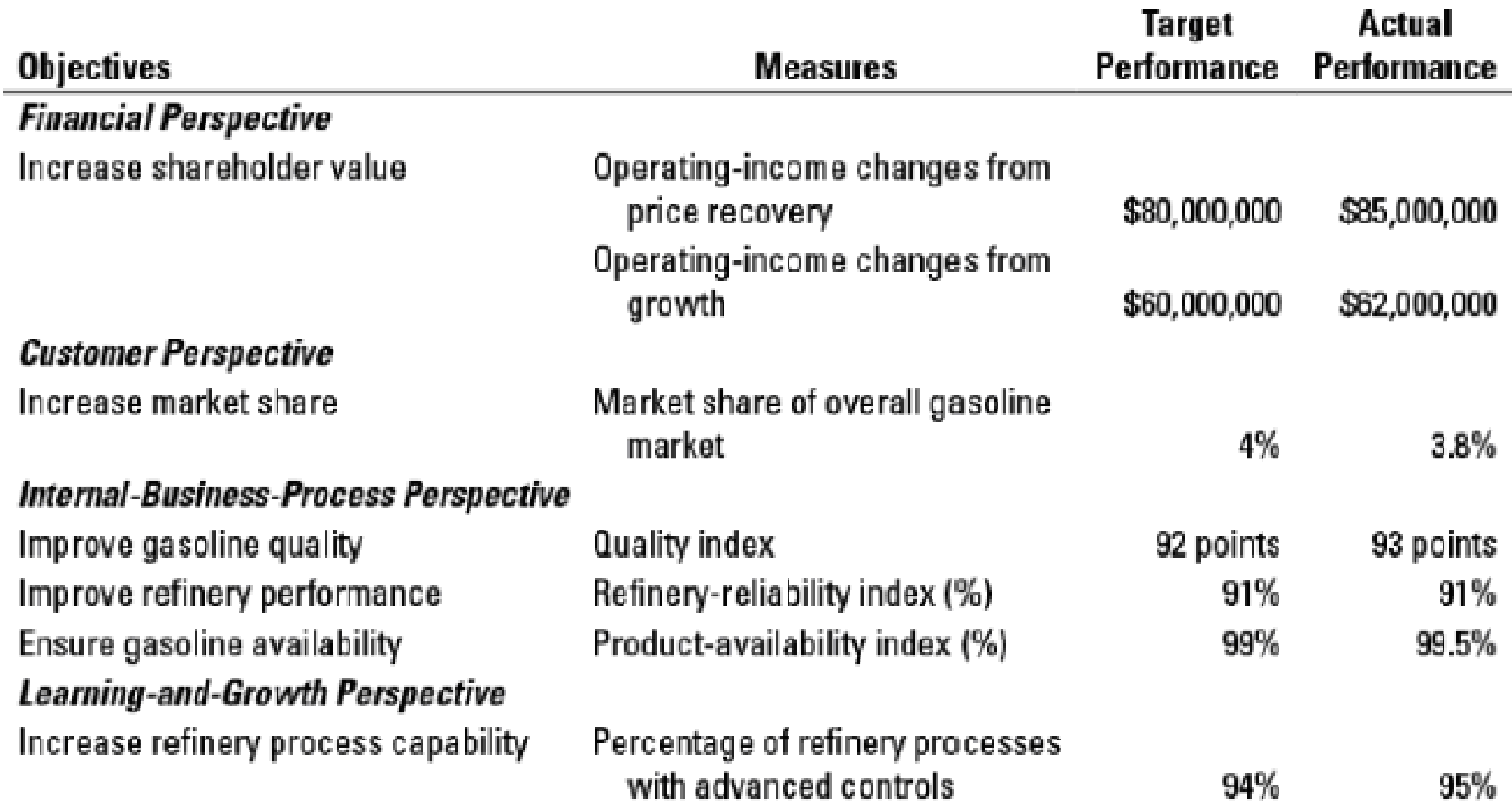
Balanced scorecard. (R. Kaplan, adapted) Petrocal, Inc., refines gasoline and sells it through its own Petrocal gas stations. On the basis of

- 1. Was Petrocal successful in implementing its strategy in 2017? Explain your answer.
- 2. Would you have included some measure of employee satisfaction and employee training in the learning-and-growth perspective? Are these objectives critical to Petrocal for implementing its strategy? Why or why not? Explain briefly.
- 3. Explain how Petrocal did not achieve its target market share in the total gasoline market but still exceeded its financial targets. Is ‘‘market share of overall gasoline marker the correct measure of market share? Explain briefly.
- 4. Is there a cause-and-effect linkage between improvements in the measures in the internal-business-process perspective and the measure in the customer perspective? That is, would you add other measures to the internal-business-process perspective or the customer perspective? Why or why not? Explain briefly.
- 5. Do you agree with Petrocal’s decision not to include measures of changes in operating income from productivity improvements under the financial perspective of the balanced scorecard? Explain briefly.
Want to see the full answer?
Check out a sample textbook solution
Chapter 12 Solutions
Horngren's Cost Accounting Plus MyLab Accounting with Pearson eText -- Access Card Package (16th Edition)
- Luxe Inc., a chain of gasoline service stations, has a strategy of charging premium prices for its gasoline by providing excellent service such as attendants to pump gas, clean restrooms, and free air for tire inflation. Its balanced scorecard performance measures include: Increase in operating income through cost reduction (Financial); market share in the overall gasoline market (Customer); wait-time at the pump (Internal Business Processes); and employee bonus based on number of customers served (Learning and Growth). Indicate whether each of these performance measures is appropriate, given Luxes strategy.arrow_forwardBasic Inc., a chain of gasoline service stations, has a strategy of charging discount prices for its gasoline by providing very little service and charging relatively high prices for the goods in its attached mini-market. Its balanced scorecard performance measures include: Increase in operating income through cost reduction (Financial); market share in the overall gasoline market (Customer); wait-time at the pump (Internal Business Processes); and store manager and employee bonus based on number of customers served (Learning and Growth). Indicate whether each of these performance measures is appropriate, given Basics strategy.arrow_forwardSunny Nights Inc. is completely powered by the city power grid, but management is considering switching fuel sources in an effort to improve the publics perception of the companys corporate social responsibility. Within the next five years, management wants the company to be completely solar powered and to market this change through company advertising. Upon consulting with Sunny Nights, you have determined that an appropriate course of action is to include this CSR activity as a strategic objective on the companys current balanced scorecard. a. Determine the appropriate performance perspective for the CSR strategic objective. b. Suggest one possible performance metric for the objective. c. Determine an appropriate yearly performance target for the performance metric.arrow_forward
- A chemical engineer working for a large chemical products company was asked to make a recommendation about which of three mutually exclusive revenue alternatives should be selected for improving the marketability of personal care products used for conditioning hair, cleansing skin, removing wrinkles, etc. The alternatives (X, Y, and Z) were ranked in order of increasing initial investment and then compared by incremental rate of return analysis. The rate of return on each increment of investment was less than the company’s MARR of 17% per year. The alternative to select is: (a) DN (b) Alternative X (c) Alternative Y (d) Alternative Zarrow_forwardBalanced scorecard. Pineway Electric manufactures electric motors. It competes and plans to grow by selling high-quality motors at a low price and by delivering them to customers in a reasonable time after receiving customers’ orders. There are many other manufacturers who produce similar motors. Pineway believes that continuously improving its manufacturing processes and having satisfied employees are critical to implementing its strategy in 2017. Q.Ramsey Corporation, a competitor of Pineway, manufactures electric motors with more sizes and features than Pineway at a higher price. Ramsey’s motors are of high quality but require more time to produce and so have longer delivery times. Draw a simple customer preference map as in Exhibit 12-1 for Pineway and Ramsey using the attributes of price, delivery time, quality, and design features.arrow_forwardDuke Energy reported that the cost of electricity for an efficient home in a particular neighborhood of Cincinnati, Ohio, was $104 per month. A researcher believes that the cost of electricity for a comparable neighborhood in Chicago, Illinois, is higher. A sample of homes in this Chicago neighborhood will be taken and the sample mean monthly cost of electricity will be used to test the following null and alternative hypotheses. Assume the sample data lead to rejection of the null hypothesis. What would be your conclusion about the cost of electricity in the Chicago neighborhood? What is the Type I error in this situation? What are the consequences of making this error? What is the Type II error in this situation? What are the consequences of making this error?arrow_forward
- Lonnies Shipping Co. is considering switching to an all-electric fleet to minimize emissions. Lonnie wants to gradually implement this change over the next 10 years. The company currently has a fleet of 100 trucks, half of which are electric-powered. Upon consulting with Lonnie, you have determined that an appropriate course of action is to include this CSR activity as a strategic objective in the companys current balanced scorecard. a. Under which performance perspective should the CSR strategic objective be placed? b. Suggest one possible performance metric for the CSR strategic objective. c. Determine an appropriate yearly performance target for the performance metric you suggested in part (b).arrow_forwardMidwest Mfg. uses a balanced scorecard as part of its performance evaluation. The company wants toinclude information on its sustainability efforts in its balanced scorecard. For each of the sustainabilityitems below, indicate the most likely balanced scorecard perspective it relates to. Label your answers usingC (customer), P (internal process), I (innovation and learning), or F (financial). Gallons of water usedarrow_forwardIf you were John Glaser, what would you do? Why? How will you measure the risks and rewards? Suppose Compass Box had whisky that they had bought 6 years ago as new fill whisky with inventoriable costs incurred to date (i.e., historic cost) of £300, completion cost of £130, and an expected selling price of £600. Assume that the cost to buy comparable whisky on the spot market (i.e., replacement cost) is more than £300. What journal entries would be required if: The selling price dropped to £500? The selling price remained at £600, but the replacement cost dropped to £100? The selling price dropped to £400 and the replacement cost dropped to £100? The selling price previously dropped to £400, and then recovered to £650?arrow_forward
- The Monroe Forging Company sells a corrugated steel product to the Standard Manufacturing Company and is in competition on such sales with other suppliers of the Standard Manufacturing Co. The vice president of sales of Monroe Forging Co. believes that by reducing the price of the product, a 40% increase in the volume of units sold to the Standard Manufacturing Co. could be secured. As the manager of the cost and analysis department, you have been asked to analyze the proposal of the vice president and submit your recommendations as to whether it is financially beneficial to the Monroe Forging Co. You are specifically requested to determine the following: (a) Net profit or loss based on the pricing proposal. (b) Unit sales volume under the proposed price that is required to make the same $40,000 profit that is now earned at the current price and unit sales volume. Use the following data in your analysis:arrow_forwardDarren Mack owns the Gas n’ Go convenience store and gasstation. After hearing a marketing lecture, he realizes thatit might be possible to draw more customers to his high-margin convenience store by selling his gasoline at a lowerprice. However, the Gas n’ Go is unable to qualify for volumediscounts on its gasoline purchases, and therefore cannot sellgasoline for profit if the price is lowered. Each new pump willcost $95,000 to install, but will increase customer traffic in thestore by 1,000 customers per year. Also, because the Gas n’Go would be selling its gasoline at no profit, Darren plans onincreasing the profit margin on convenience store items in-crementally over the next five years. Assume a discount rateof 8 percent. The projected convenience store sales per cus-tomer and the projected profit margin for the next five yearsare as follows:a. What is the NPV of the next five years of cash flows ifDarren had four new pumps installed?b. If Darren required a payback period of four…arrow_forwardDarren Mack owns the Gas n’ Go convenience store and gasstation. After hearing a marketing lecture, he realizes thatit might be possible to draw more customers to his high-margin convenience store by selling his gasoline at a lowerprice. However, the Gas n’ Go is unable to qualify for volumediscounts on its gasoline purchases, and therefore cannot sellgasoline for profit if the price is lowered. Each new pump willcost $95,000 to install, but will increase customer traffic in thestore by 1,000 customers per year. Also, because the Gas n’Go would be selling its gasoline at no profit, Darren plans onincreasing the profit margin on convenience store items in-crementally over the next five years. Assume a discount rateof 8 percent. The projected convenience store sales per cus-tomer and the projected profit margin for the next five yearsare as follows: a. What is the NPV of the next five years of cash flows ifDarren had four new pumps installed?b. If Darren required a payback period of four…arrow_forward
 Principles of Cost AccountingAccountingISBN:9781305087408Author:Edward J. Vanderbeck, Maria R. MitchellPublisher:Cengage Learning
Principles of Cost AccountingAccountingISBN:9781305087408Author:Edward J. Vanderbeck, Maria R. MitchellPublisher:Cengage Learning Essentials of Business Analytics (MindTap Course ...StatisticsISBN:9781305627734Author:Jeffrey D. Camm, James J. Cochran, Michael J. Fry, Jeffrey W. Ohlmann, David R. AndersonPublisher:Cengage Learning
Essentials of Business Analytics (MindTap Course ...StatisticsISBN:9781305627734Author:Jeffrey D. Camm, James J. Cochran, Michael J. Fry, Jeffrey W. Ohlmann, David R. AndersonPublisher:Cengage Learning Survey of Accounting (Accounting I)AccountingISBN:9781305961883Author:Carl WarrenPublisher:Cengage Learning
Survey of Accounting (Accounting I)AccountingISBN:9781305961883Author:Carl WarrenPublisher:Cengage Learning Financial And Managerial AccountingAccountingISBN:9781337902663Author:WARREN, Carl S.Publisher:Cengage Learning,
Financial And Managerial AccountingAccountingISBN:9781337902663Author:WARREN, Carl S.Publisher:Cengage Learning, Managerial AccountingAccountingISBN:9781337912020Author:Carl Warren, Ph.d. Cma William B. TaylerPublisher:South-Western College Pub
Managerial AccountingAccountingISBN:9781337912020Author:Carl Warren, Ph.d. Cma William B. TaylerPublisher:South-Western College Pub




